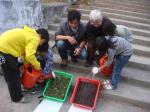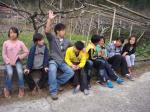Category Archives: Atayal
Episode 93: Temporary Bridge
For Atayal living by the river, the hongu (temporary bridge) is an excellent way to travel between villages.In the past, Atayal men hunt for a living. In order to ensure that women can pass rivers safely to forage, the men of the village work together to build temporary bridges, which also helps with gathering water.
The Atayal temporary bridge used bamboo, crape myrtle, vines, and grass fern as materials, but due to different environments, the bridges differ from place to place.But how did they build temporary bridges, and what scientific principles are used?
Episode 91: Facial Tattoo Pt. 2
Ptasan, or facial tattoos, has different patterns due to different tribes. U shaped patterns belong to the Sediq and the Truku. The V shape belongs to the Atayal.
Traditional tattoo methods differ from modern methods in that modern tattoo equipments are electrical. They use medical grade stainless steel for their needles. After disinfecting it, they would seal the package. Once it’s used, the equipment would be discarded. In the past, the dye is a mixture of pine charcoal, so there is only one color. Now, using various plants, a wide variety of colors are available.
Episode 90: Facial Tattoo Pt. 1
Facial Tattoo is the most important cultural representation for the Atayal, Sediq, and Truku. In the traditional cultures of these tribes, facial tattoo identify the wearer’s tribe, age, and abilities. For boys and girls, they could get their tattoos on their foreheads at the age of 5. As for men’s chin tattoo and women’s cheek tattoo, they are only available once the person has become an adult. In the past, the standard for adulthood is that a woman must be able to weave, and a man must be able to hunt and has headhunted.
Facial tattoo is applied by a tattoo master. The tattoo tool is a set of brush-shaped needles or the thorn of a plant. The coloring is a mixture of pine charcoal.
Episode 67: Terraced Fields
The Tao of Lanyu know that water is essential, therefore, they treat the development of every terraced field with the utmost respect. Therefore, we find a very smart tool in each of the fields, a barrel. What role does it play in a field? Through the students observation, we find out the differences between the Yeheng fields and Lanyu’s fields.
Episode 64: Fish Trap
This episode introduces an Atayal traditional fishing tool, the fish trap. Mostly made of bamboo, the fish trap is often put into creeks with baits inside. After a rain, it could also be put into ditches to catch fish and shrimp.
The trap uses a one-way valve mechanism. The science teacher helps kids to find out which every objects also use this mechanism. Using the principles of this theory, the kids create a magnetic slingshot.
Episode 63: The Crape Myrtle
This episode introduces one of Atayal’s traditional natural resources, the crape myrtle. Taws and the kids observe its environment to understand the tree’s characteristic. Its trunk is solid, its leaves can cure snakebites and heal wounds. Its structure is also very dense, great to be made into tools for farming, construction, and the home. In the past, the crape myrtle is an important source for fabric dyes. Today, the tree plays an important role in soil and water conservation.
Episode 61: Hot Spring
This episode introduces the Atayal’s natural resources, the hot springs of Wulai. The formation of the hot spring is closely related to volcanoes. During volcanic eruptions, a volcano would often emit magma. However, sometimes, some magma would remain close to the surface. These underground magma would slowly release heat into the ground to heat the water above. In some regions without volcanoes, magma remains active and hot springs can still be formed.
By learning about pressure and boiling eggs, the kids realize how pressure can affect the flow of water and turn groundwater into hot springs.
Episode 50: Preserved Meat
The Atayal have a very special food called “tmmyan” (preserved meat), which is created through many chemical reactions. The process uses uncooked millet and meat. While in the contain, they would ferment. The preserved meat would contain a sour taste that is loved by the Atayal people. Through experiments, kids find out that starch would ferment in a confined space because there are many different types of fungi in the air.

Episode 47: Fish Spear and Fishing Glass
Fish spear and fishing glass are important tools for Atayal hunters. Throughout the ages, they had perfected their fishing techniques, and an elder will teach us a few tricks. Why does the spear have to be made of bamboo? Why must they fish at night? They will also explain how a fishing glass takes advantage of the scientific principle of light refraction so hunters can see into the water.


















